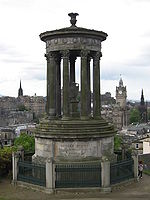
Dugald Stewart Monument
Encyclopedia

Scotland
Scotland is a country that is part of the United Kingdom. Occupying the northern third of the island of Great Britain, it shares a border with England to the south and is bounded by the North Sea to the east, the Atlantic Ocean to the north and west, and the North Channel and Irish Sea to the...
philosopher
Philosophy
Philosophy is the study of general and fundamental problems, such as those connected with existence, knowledge, values, reason, mind, and language. Philosophy is distinguished from other ways of addressing such problems by its critical, generally systematic approach and its reliance on rational...
Dugald Stewart
Dugald Stewart
Dugald Stewart was a Scottish Enlightenment philosopher and mathematician. His father, Matthew Stewart , was professor of mathematics in the University of Edinburgh .-Life and works:...
(1753–1828). It is situated on top of Calton Hill
Calton Hill, Edinburgh
Calton Hill is a hill in central Edinburgh, Scotland, just to the east of the New Town. Views of, and from, the hill are often used in photographs and paintings of the city....
, overlooking Edinburgh
Edinburgh
Edinburgh is the capital city of Scotland, the second largest city in Scotland, and the eighth most populous in the United Kingdom. The City of Edinburgh Council governs one of Scotland's 32 local government council areas. The council area includes urban Edinburgh and a rural area...
city centre.
Dugald Stewart was a Professor
Professor
A professor is a scholarly teacher; the precise meaning of the term varies by country. Literally, professor derives from Latin as a "person who professes" being usually an expert in arts or sciences; a teacher of high rank...
of the University of Edinburgh
University of Edinburgh
The University of Edinburgh, founded in 1583, is a public research university located in Edinburgh, the capital of Scotland, and a UNESCO World Heritage Site. The university is deeply embedded in the fabric of the city, with many of the buildings in the historic Old Town belonging to the university...
, holding the chair of moral philosophy from 1786 until his death. The Royal Society of Edinburgh
Royal Society of Edinburgh
The Royal Society of Edinburgh is Scotland's national academy of science and letters. It is a registered charity, operating on a wholly independent and non-party-political basis and providing public benefit throughout Scotland...
commissioned the monument, and selected the site. The monument was built in 1831 to the design of architect William Henry Playfair
William Henry Playfair
William Henry Playfair FRSE was one of the greatest Scottish architects of the 19th century, designer of many of Edinburgh's neo-classical landmarks in the New Town....
, who modelled his design on the Choragic Monument of Lysicrates
Choragic Monument of Lysicrates
The Choragic Monument of Lysicrates near the Acropolis of Athens was erected by the choregos Lysicrates, a wealthy patron of musical performances in the Theater of Dionysus to commemorate the award of first prize in 335/334 BCE, to one of the performances he had sponsored...
in Athens
Athens
Athens , is the capital and largest city of Greece. Athens dominates the Attica region and is one of the world's oldest cities, as its recorded history spans around 3,400 years. Classical Athens was a powerful city-state...
, Greece
Greece
Greece , officially the Hellenic Republic , and historically Hellas or the Republic of Greece in English, is a country in southeastern Europe....
. This example of the architecture of ancient Greece
Architecture of Ancient Greece
The architecture of Ancient Greece is the architecture produced by the Greek-speaking people whose culture flourished on the Greek mainland and Peloponnesus, the Aegean Islands, and in colonies in Asia Minor and Italy for a period from about 900 BC until the 1st century AD, with the earliest...
had been brought to wider attention by James "Athenian" Stuart and Nicholas Revett
Nicholas Revett
Nicholas Revett was a Suffolk gentleman and amateur architect and artist.He is best known for his famous work with James Stuart documenting the ruins of ancient Athens. Its illustrations compose 5 folio volumes and include 368 etched and engraved plates, plans and maps drawn at scale...
's illustrated survey, The Antiquities of Athens, published in 1762. The Choragic Monument also provided the model for the nearby Robert Burns Monument, designed by Thomas Hamilton
Thomas Hamilton (architect)
Thomas Hamilton was a Scottish architect, based in Edinburgh. Born in Glasgow, his works include: the Dean Orphan Hospital, now the Dean Gallery; the Royal High School on the Calton Hill, long considered as home for the Scottish Parliament; Bedlam Theatre; the George IV Bridge, which spans the...
around the same time. The monument forms part of a collection of Greek revival architecture
Greek Revival architecture
The Greek Revival was an architectural movement of the late 18th and early 19th centuries, predominantly in Northern Europe and the United States. A product of Hellenism, it may be looked upon as the last phase in the development of Neoclassical architecture...
in the area, including the National Monument
National Monument, Edinburgh
The National Monument of Scotland, popularly referred to as Scotland's Disgrace, the Pride and Poverty of Scotland or Edinburgh's Shame, is an unfinished building on Calton Hill in Edinburgh...
and the former Royal High School building. The monument is a category A listed building.

